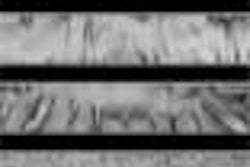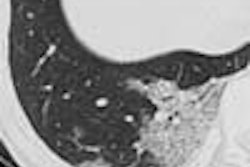The U.S. computer-aided detection (CAD) market more than doubled in 2002, turning in $65.2 million in revenues, according to market research firm Frost & Sullivan. The San Jose, CA-based firm projects the market to reach $100.7 million by 2006, with a compounded annual growth rate (CAGR) of 11.5%.
"End users purchased these systems (in 2002) at a blinding pace," said Frost research analyst Jim Clayton.
Frost segmented the CAD market into mammography, chest/lung, and virtual colonoscopy applications. The mammography CAD segment included both mammography and MRI CAD applications.
Today's CAD market is dominated by use with mammography studies, which generated nearly all of the revenues and units sold in 2002, Clayton said. But vendors are also devoting significant development resources for products in the chest/lung and virtual colonoscopy segments, Clayton said.
"All of the products under development for these two segments are destined for integration with CT," he said. "One product that is utilized by x-ray for the lung nodule detection market has already received approval for marketing in the U.S."
Despite the impressive market growth rate, competitive pressure has intensified as new systems debuted, Clayton said. New firms are expected to continue to enter the market, as the sector expands beyond mammography applications.
"As this transition occurs, the large modality manufacturers will likely begin to exert their influence as CAD systems are integrated with the CT and MRI modalities they produce," he said. "The introduction and acceptance of CAD applications in these markets is very important if this industry wants to reach its full potential."
Not only are integrated multimodality CAD solutions important for the development of the industry, but the size of the CT and MRI installed base also represents a sizeable revenue stream for the market, Clayton said.
Market drivers
Over the past three years, mammography CAD has begun receiving reimbursement, with subsequent increases. These advances have driven exponential growth in the market, Clayton said.
The reimbursement rate for 2003 is $19.13 per procedure. Unlike previous years, that rate also applies for digital procedures, Clayton said.
"Increases in reimbursement rates are important because that means the end user can now exploit the economic effects of CAD in addition to the clinical benefits," Clayton said. "(The economic benefit) provides the biggest incentive for adoption of CAD because it promotes a better chance of generating a return on investment. In addition, (the clinical advantages) provide a secondary benefit for the facility, because it's more likely to attract patients if CAD is installed."
While reimbursement rate hikes are increasing at a slower rate, they are expected to continue to continue to grow throughout Frost's forecast period (through 2006), due to the benefits of early breast cancer detection, Clayton said.
Reimbursement rate gains are good for the market, but the overall reimbursement environment could benefit from uniformity of coverage and acceptance of CAD screening with modalities other than mammography, Clayton said. For example, private insurers don't always cover mammography CAD screening, and if they do, reimbursement often differs depending on the provider, state of residence, and population demographics.
Acceptance of CAD screening for other modalities may face some resistance due to negative connotations associated with whole-body CT screening. This dynamic is likely to change, however, as multimodality products are developed and begin the Food and Drug Administration approval process, he said.
Competition among CAD vendors is driving growth and market acceptance, helped by the introduction of innovative products from new entrants, Clayton said. End users now have a selection of products to choose from at varying price points.
The market is also now profitable enough to attract and support other vendors, he said. In addition, the new products, some of which target other modalities outside of mammography, have been key to the development of the market over the last two years.
The introduction of integrated and multimodality CAD packages will be a leading indicator of market growth and viability towards the end of the forecast period (through 2006), Clayton said.
"The end-user market will benefit from the introduction of these products, because they will be able to lower their cost of ownership and provide additional services," he said. "CAD vendors will benefit because multimodality solutions will provide additional distribution channels and revenue streams from their products. This will be crucial to the acceptance of CAD as a standard of care in other disciplines in the future."
Other trends
In other key trends influencing market development, independent imaging clinics have tended to embrace CAD at a much faster pace than other healthcare facilities. Frost directly attributes this trend to the improved economics of CAD.
An emerging trend -- the introduction of integrated systems for mammography and other modalities -- is expected to have a greater impact in the next year to 18 months as those systems are rolled out, he said.
"The prospects for these products are quite good, as hospitals and imaging clinics have proven that they prefer an integrated solution because of the possible lower cost of ownership," he said. "For example, those facilities that have purchased digital mammography solutions are more apt to purchase an integrated CAD solution at the same time than with other (non-digital) mammography systems."
By Erik L. RidleyAuntMinnie.com staff writer
July 15, 2003
Related Reading
Clinical community continues to assess mammo CAD’s efficacy, June 30, 2003
Computer-aided detection enhances breast MRI, June 6, 2003
Effective breast CAD still harbors a few workflow caveats, June 3, 2003
CAD mass markers aid in reduction of mammographic interpretation errors, March 7, 2003
Researchers compare CAD systems for mammography, December 6, 2002
Copyright © 2003 AuntMinnie.com





















